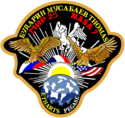Nikolai Michailowitsch Budarin
| Nikolai Budarin | |
|---|---|
 | |
| Land | Russland |
| Organisation | Roskosmos |
| ausgewählt | 25. Januar 1989 |
| Einsätze | 3 Raumflüge |
| Start des ersten Raumflugs | 27. Juni 1995 |
| Landung des letzten Raumflugs | 4. Mai 2003 |
| Zeit im Weltraum | 444d 1h 25min |
| EVA-Einsätze | 8 |
| EVA-Gesamtdauer | 44h 25min |
| ausgeschieden | September 2004 |
| Raumflüge | |
| |
Nikolai Michailowitsch Budarin (russisch Николай Михайлович Бударин; * 29. April 1953 in Kirja, Tschuwaschien) ist ein ehemaliger russischer Kosmonaut.
Raumflüge
Mir EO-19
Am 27. Juni 1995 flog Nikolai Budarin als Teil der Stammbesatzung Mir EO-19 als erster russischer Weltraumneuling mit einem Space Shuttle zur Mir. Er kam mit dem Raumschiff Sojus TM-21 am 11. September 1995 zur Erde zurück.
MIR EO-25
Vom 30. Januar bis zum 25. August 1998 war Budarin als Bordingenieur zur Stammbesatzung Mir EO-25 auf der Raumstation Mir.
ISS-Expedition 6
Vom 25. November 2002 bis zum 3. Mai 2003 war er im Rahmen der ISS-Expedition 6 an Bord der Internationalen Raumstation.
Politik
2007 wurde er in die Duma, das russische Parlament, gewählt.
Siehe auch
- Liste der Raumfahrer
- Liste bemannter Missionen zur Raumstation Mir
- Bemannte Raumfahrt
- Liste der Weltraumausstiege
- Liste der bemannten Raumflüge
- Russische Raumfahrt
- Liste bemannter Missionen zur Internationalen Raumstation
Weblinks
- Biografie von Nikolai Michailowitsch Budarin in der Encyclopedia Astronautica (englisch)
- Biografie von Nikolai Michailowitsch Budarin beim Juri-Gagarin-Kosmonautentrainingszentrum (russisch)
- Kurzbiografie von Nikolai Michailowitsch Budarin bei spacefacts.de
| Personendaten | |
|---|---|
| NAME | Budarin, Nikolai Michailowitsch |
| ALTERNATIVNAMEN | Бударин, Николай Михайлович (russisch) |
| KURZBESCHREIBUNG | russischer Kosmonaut |
| GEBURTSDATUM | 29. April 1953 |
| GEBURTSORT | Kirja, Tschuwaschische Autonome Sozialistische Sowjetrepublik, Russische Sozialistische Föderative Sowjetrepublik, Sowjetunion |
Auf dieser Seite verwendete Medien
* This is the crew patch for the STS-113 mission, which will be the eleventh American (11A) assembly flight to the International Space Station (ISS). The primary mission will be to take the Expedition Six crew to the ISS and return the Expedition Five crew to Earth. STS-113 will be the first flight in the assembly sequence to install a major component in addition to performing a crew exchange. The Port 1 Integrated Truss Assembly (P1) will be the first truss segment on the left side of the ISS. P1 will provide an additional three External Thermal Control System radiators, adding to the three radiators on the Starboard 1 (S1) Integrated Truss Assembly. The installation and outfitting of P1 will require three extravehicular activities (space walks) as well as coordination between the Shuttle Robotic Manipulator System and the Space Station Robotic Manipulator System. The patch depicts the Space Shuttle Endeavour docked to the ISS during the installation of the P1 truss with the gold astronaut symbol in the background.
- The seven stars at the top left center of the patch are the seven brightest stars in the constellation Orion. They represent the combined seven crew members (four Shuttle and three Expedition Six). The three stars to the right of the astronaut symbol represent the returning Expedition Five crew members. The Shuttle crew names are on the solar arrays of the P6 truss. The ISS Expedition crew names are in a chevron that also features the American and Russian flags. The Expedition 6 crew names are on top of the Expedition 5 crew names, since Expedition 6 goes up while Expedition 5 goes down. The Roman Numeral CXIII represents the mission number 113.
Patch for the Mir EO-19 expedition to the Mir space station in 1995.
The patch was redrawn by Jorge Cartes (JCR).
Common patch for the Russian Mir EO-25 crew members, the American NASA 7 crew member and the French Pégase crew member to the Mir space station in 1998.
The official crew patch for the Russian Soyuz TM-27 mission, which delivered the EO-25 and Pegasé crews to the space station Mir.
The International Space Station (ISS) Expedition 6 crew patch depicts the station orbiting the Earth on its mission of international cooperation and scientific research. The Earth is placed in the center of the patch to emphasize that work conducted aboard this orbiting laboratory is intended to improve life on our home planet. The shape of the Space Station’s orbit symbolizes the role that experience gained from ISS will have on future exploration of our solar system and beyond. The American and Russian flags encircling the Earth represent the native countries of the Expedition 6 crew members, which are just two of the many participant countries contributing to the ISS and committed to the peaceful exploration of space.
STS-71 Mission Insignia
The STS-71 crew patch design depicts the orbiter Atlantis in the process of the first international docking mission of the Space Shuttle Atlantis with the Russian Space Station Mir. The names of the 10 astronauts and cosmonauts who flew aboard the orbiter are shown along the outer border of the patch. The rising sun symbolizes the dawn of a new era of cooperation between the two countries. The vehicles Atlantis and Mir are shown in separate circles converging at the center of the emblem symbolizing the merger of the space programs of the two space faring nations. The flags of the United States and Russia emphasize the equal partnership of the mission. The joint program symbol at the lower center of the patch acknowledges the extensive contributions made by the Mission Control Centers (MCC) of both countries. The crew insignia was designed by aviation and space artist, Bob McCall, who also designed the crew patch for the Apollo Soyuz Test Project (ASTP) in 1975, the first international space docking mission.






